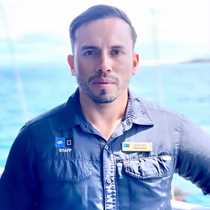Genovesa Island (Darwin Bay and Prince Philippe Steps)
This morning we anchored National Geographic Islander in the middle of a rim belonging to an old volcano. After a wet landing on a white coralline beach we disembarked at Darwin Bay. This island has no introduced animals, so its landscape and wildlife are pristine and the interaction among species truly shows nature on its own stage. As we walked along the mangroves at the beach we were able to see a large colony of red-footed boobies, a lot of them nesting and some others getting ready to lay their eggs, collecting nesting material to build their place among the branches of the red mangroves.
This island holds a very large nesting area for the yellow crown night herons; some juveniles of this species were seen among the cliffs, opening their wings so the cool air can go through in the very sunny hours of the day. Some swallow-tail gulls and Nazca boobies were seen on the sandy Darwin Beach and of course the very dominant Frigate birds were patrolling the sky, being the pirates of the Galápagos.
The end of the warm season in Galápagos had produced a very large number of nesting birds on Genovesa, known as the “seabird island.” Later in the day we went snorkeling along the titanic cliffs of Genovesa and some of us had the opportunity to swim with Galápagos fur sea lions. Some species of colorful tropical fish were seen on the vertical walls of this place. Kayaking was offered after lunch and during this activity we could see the many different species of birds nesting on the cliffs, such as the very elegant red-billed tropicbird.
In the afternoon we visited the cliff side of Genovesa to look for the short-eared owls that were hunting for storm petrels. We saw a couple of them blending perfectly with the background colors of the rusty lava fields.
We finished our expedition in Galápagos with a very interesting day full of life and amazing scenery.




